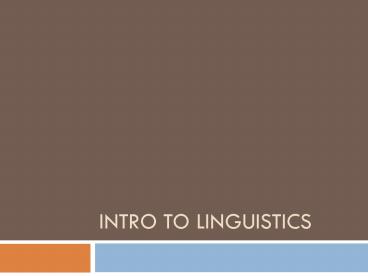INTRO TO LINGUISTICS - PowerPoint PPT Presentation
1 / 18
Title:
INTRO TO LINGUISTICS
Description:
INTRO TO LINGUISTICS KNOW LEARNED QUESTIONS KNOW LEARNED QUESTIONS What do you know about linguistics , if anything? What did you learn about ... – PowerPoint PPT presentation
Number of Views:200
Avg rating:3.0/5.0
Title: INTRO TO LINGUISTICS
1
INTRO TO LINGUISTICS
2
KNOW LEARNED QUESTIONS
- KNOW
- LEARNED
- QUESTIONS
- What do you know about linguistics, if
anything? - What did you learn about linguistics that
particularly stands out? - Identify one question or idea this has topic
raised for you.
3
Linguistics is
- The study of the nature and structure of language
and languages.
4
Varieties of Linguistic Study
- Historical Linguistics The study of the
histories and pre-histories of languages, with
the discovery of ancient connections between
languages, and with the study of language change.
http//www.lsadc.org/info/ling-fields-socio.cfm
5
Varieties of Linguistic Study
- A person interested in historical linguistics
could study words within the English language
that have been borrowed from other languages,
such as Latin - Latin loans organum (organ), rosa (rose), scola
(school) - prior (prior), hymnus (hymn), credo (creed)
- Or, might study the historical roots of the Nova
Scotian dialect by looking at patterns of
immigration.
6
Varieties of Linguistic Study
- Sociolinguistics studies language as it
represents fundamental dimensions of social
behavior and human interaction. It is concerned
with - language attitudes among large populations on a
national level - the fact that language tells us how we organize
our social relationships within a particular
community - how people manage their language in relation to
their cultural backgrounds.
http//www.lsadc.org/info/ling-fields-socio.cfm
7
How We Study Language(s)
- Language is studied in four main ways
- Phonology
- Morphology
- Syntax
- Semantics
8
How We Study Language(s)
- Phonology
- The study of the systems and patterns of speech
sounds in a language. - A phoneme is the smallest unit of meaningful
sound that can distinguish words in a language. - You can use minimal pairs, such as pin and
bin , as evidence for phonemes each means
something different, but they only differ in
terms of one sound.
9
How We Study Language(s)
- Phonemes are not universal different languages
have different units of meaningful sound. - Compare the phonemic alphabets of German,
Spanish, and English - http//www.uiowa.edu/acadtech/phonetics/
10
How We Study Language(s)
- Morphology
- The study of the internal structure of words,
and of the rules by which words are formed. - A morpheme is the smallest unit of linguistic
meaning (not to be confused with a phoneme, which
is the smallest unit of meaningful sound). - pin and bin are each single morphemes, that
are comprised of a single syllable.
http//www.ling.udel.edu/arena/morphology.html
11
How We Study Language(s)
- A single word may be composed of more than one
morpheme though. For example - Two morphemes
- Coy ish
- Desire able
- Three morphemes
- Coy ish ness
- Desire able ity
- Four morphemes
- Un desire able ity
- Gentle man li ness
- More than four morphemes
- Un gentle man li ness
12
How We Study Language(s)
- How many morphemes do you count in the following
words? - Coquettishness
- Frankly
- Exceedingly
- Pestles
- Antidisestablishmentarianism
13
How We Study Language(s)
- Syntax
- The study of the structure and ordering of
components within a sentence. - When looking at syntax, we notice and examine
parts of speech (subject, verb, noun, pronoun,
adjective, etc.) and word order. - For example, most English sentences tend to
follow a Subject-Verb-Object order - The dog ate my flash drive.
- Monica gave Starr a blue dress.
14
How We Study Language(s)
- Semantics
- The study of the meaning of words, phrases, and
sentences. - Semantic change is when a word changes meaning.
It can become wider in meaning or narrower, or
more positive or more negative. An example is the
word 'bad', which has changed meaning from
negative to positive in some contexts.
http//www.teachingenglish.org.uk/think/knowledge-
wiki/semantics
15
Attitudes in the Study of Language(s)
- There are two dominant attitudes or approaches to
the study of language(s) Prescriptive
Descriptive
16
Attitudes in the Study of Language(s)
- PRESCRIPTIVE APPROACH
- DESCRIPTIVE APPROACH
- The view that one variety of language has an
inherently higher value than others, and that
this ought to be imposed on the whole of the
speech community. - Especially applied to grammar, vocabulary
pronunciation - Uses ideology of correctness
- Its main aim is to describe and explain the
patterns of usage which are found in all
varieties of the language, whether they are
socially prestigious or not. - In other words, this approach does not condemn
dialects as ugly, incorrect, or illogical,
simply because they adhere to different rules
Crystal, David. The Cambridge Encyclopedia of the
English Language. New York Press Syndicate of
the U of Cambridge, 1995.
17
Attitudes in the Study of Language(s)
- What attitudes do you believe are found in the
education system? Why? - Do you agree that there is/are varieties of
language that have an inherently higher value
than others? Why or why not? - Why might prescriptive attitudes be viewed as
oppressive by some?
18
KNOW LEARNED QUESTIONS
- KNOW
- LEARNED
- QUESTIONS
- What do you know about linguistics, if
anything? - What did you learn about linguistics that
particularly stands out? - Identify one question or idea this has topic
raised for you.































